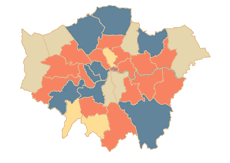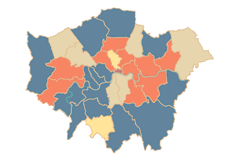Experts Predict Labour will hold Ealing
Cameron must win 'bellwether borough' to become PM
A report on the forthcoming London Borough elections has made a series of detailed predictions on the results. They are predicting at a local level that Labour control will continue in both Hounslow and Ealing with Hammersmith and Fulham falling to the Conservatives.
The report is by the London Communications Agency (LCA), a specialist communications consultancy focusing on London and London issues, and Tony Travers of the London School of Economics (LSE). The predictions are based on 'a combination of top-line analysis of each borough, current national political trends, and gut instinct.'
They say that Ealing Council only has an outside chance of switching to 'no overall control'. Currently Labour hold 48 seats, against 17 for the Conservatives, 4 for the Liberal Democrats (three of which are in Southfield ward) and two others.
They highlight East Acton of one of 4 key marginal wards where the Conservatives could expect to gain at least 5 extra seats. However, despite the issue of the tram and what the report describes as the 'more responsive' local Tories there would have to be a major swing against Labour for there to be a loss of overall control. Labour has a high level of support in parts of the borough; three of the top five Labour voting wards in London in 2002 were in Ealing.
London’s 32 boroughs are currently controlled by Labour, with 15, the Conservatives with 8, the Liberal Democrats
with 3 and 6 are in No Overall Control (NOC). The report predicts that Labour will end with only 10 boroughs and the Conservatives will win six on top of the eight they already control. LCA have committed to pay £250 to St. Mungo's Hospital for each borough prediction that they get wrong.
The report highlights a trend for voters in London to be 'anti-incumbent' with a tendency to vote against the party in power nationally. They say this factor alone will mean a reduction in the number of Labour controlled Councils.
Another factor has been the ongoing reduction in turnout at elections. In 1990 the turnout was 46%, in 1998 it was 34.6% and by 2002 it had dropped to 31.6%. The Government has recently launched a campaign to encourage the estimated 500,000 unregistered London residents to sign up, but if they do and don’t vote then the percentage turnout will be even lower.
David Cameron would have a very good chance of winning the next election if he could win the 'bellwether' borough of Ealing which has traditional been controlled by the party that goes onto win the next General Election. One factor that could help the Conservatives, according to the report, is their more convincing approach to attraction ethnic minority votes. The Tories have made a much greater effort to field candidates that reflect more closely the areas they are likely to represent particularly in West London.
The LCA describes the elections as the most important for at least 20 years and says the outcome will send out important signals for the main parties in the next general election.
April 6, 2006
Related links
| Related Links | |
Election Maps of London Results from 2002
LCA Prediction for 2006 Local Lib Dems unite to launch local manifesto Lib Dems target South Acton ward
|

